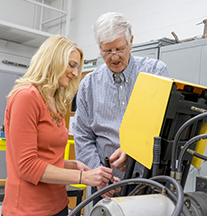April 13, 2016
Purdue 'smart' sensor predicts failures, improves safety for mechanical, medical technologies
 |
|
Brittany Newell, Purdue University assistant professor of engineering technology, and Gary W. Krutz, professor of agricultural and biological engineering, review hydraulic hoses used in mechanical machinery. Their research could determine how a new "smart" sensor can identify the integrity and strength in rubber products such as tires, pneumatic and hydraulic hoses and O-rings. The sensor could make it possible to replace a worn product before it breaks and causes additional damage or harm. (Photo by Purdue Research Foundation) |
WEST LAFAYETTE, Ind. – A Purdue University technology that can help predict failures to the integrity of a tire, hose or other mechanical and medical equipment could help increase automotive safety, improve patient care and reduce liability costs.
The technology, developed by a team lead by Gary W. Krutz, professor of agricultural and biological engineering, uses a sensor that can predict when a tire or hose is compromised and in danger of breaking up to two weeks in advance.
"Besides natural wear and tear, tires, hoses and seals are subjected to harsh and unpredictable conditions making them susceptible to damage that can cause vehicle road breakdowns and accidents and the same concerns can be said for medical hoses like breathing hoses or tubes," Krutz said. "The relative cost to replace a hydraulic hose or tire before it breaks down is substantially less if it is replaced before it breaks down. For example, it takes about $100 to replace a hose versus costs of up and greater than $100,000 for one failure occurrence. More important is the safety factor involved in these situations. Preventing a possible engine breakdown or tire blowout caused by a failure in the integrity of a product is paramount."
According to a 2003 National Highway Safety Traffic Administration report, an estimated 414 fatalities, 10,275 non-fatal injuries and 78,392 vehicle crashes have occurred annually due to flat tires or blowouts prior to tire pressure monitoring systems were installed in vehicle. In 2007, a federal law took effect that required all newly manufactured light vehicles have a Tire Pressure Monitoring System (TPMS). A 2012 National Highway Safety Traffic Administration report states that vehicles with properly inflated tires accounted were found in 3.4 percent of crashes while 96.6 percent of vehicles involved in a crash had underinflated or overinflated tires.
"The importance of having adequately inflated tires cannot be underscored," said Brittany Newell, assistant professor of engineering technology. "We propose that the same type of safety issue can be attributed to having tires whose integrity is compromised and susceptible to failure such as a blowout or tearing."
Newell said the sensor technology shows great promise in detecting similar damage or potential breakage in O-rings and v-belts, thus helping to mitigate engine failures.
"Hydraulic hoses are subject to wear and degradation due to abrasion, cycling fatigue, pressure spikes, UV radiation and introduction of incompatible fluids to a system," she said. "This is true with tires, O-rings and v-belts used in all types of machinery such as construction equipment, lawn and garden equipment, mining vehicles, and airplanes."
The technology has been tested on other components and can be used in rubber products such as vehicle isolators, door and automotive seals and orthopedic devices.
The technology is already being used in hydraulic hoses.
Eaton Corp., a Cleveland-based power management company, licensed Krutz's technology for its LifeSense sensing product. LifeSense monitors hydraulic hoses to identify the wear and tear of a hose that could lead to a failure. When the integrity of a hose is compromised, a report is automatically sent to user or for repair or replacement. This notification is provided with enough time to replace the hose during planned maintenance and saves downtime, clean-up costs, environmental damage and potential injury.
The "smart" sensor technology also has been tested on more than 100 different products including shoes, airplane wing composites, boat hulls and sporting goods.
"The potential uses of this technology touches nearly every industry," Krutz said.
The patented technology is available through the Purdue Research Foundation's Office of Technology Commercialization. Initial research funding for the tire technology came from Purdue University.
About Purdue Research Foundation Office of Technology Commercialization
The Purdue Research Foundation Office of Technology Commercialization operates one of the most comprehensive technology transfer programs among leading research universities in the U.S. Services provided by this office support the economic development initiatives of Purdue University and benefit the university's academic activities. The office is managed by the Purdue Research Foundation, which received the 2014 Incubator Network of the Year from the National Business Incubation Association for its work in entrepreneurship. For more information about funding and investment opportunities in startups based on a Purdue innovation, contact the Purdue Foundry at foundry@prf.org. For more information on licensing a Purdue innovation, contact the Office of Technology Commercialization at innovation@prf.org.
Purdue Research Foundation contact: Cynthia Sequin, 765-494-4192, casequin@prf.org
Sources: Gary Krutz, 765-494-1179, krutz@purdue.edu
Brittany Newell, bnewell1@purdue.edu 765-494-7724

